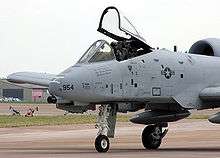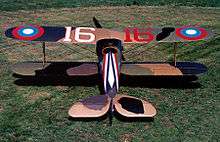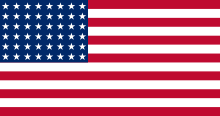United States military aircraft national insignia

This is a listing of the nationality markings used by military aircraft of the United States, including those of the US Army, US Air Force, US Navy, US Marine Corps, US Coast Guard and their predecessors. The Civil Air Patrol is also included for the World War II period because it engaged in combat operations (primarily anti-submarine flights) which its July 1946 charter since explicitly forbade.
History


The first military aviation insignias of the United States include a star used by the US Army Signal Corps, seen during the Pancho Villa punitive expedition, just over a year before American involvement in World War I began. The star was painted only on the vertical tail, in either red (the most often used color)[1] or blue (less likely, due to the strictly orthochromatic photography of that era, rendering the red star as a black one in period photos).[2] At the same time, the US Navy was using a blue anchor on the rudders of its seaplanes.
As of 19 May 1917 all branches of the military, outside of the Western Front of Europe were to use a circular dark-blue field containing the single, five-pointed regular pentagram-outline white star from the national flag, itself containing a central red circle, painted in the official flag colors.[3]
A tricolor roundel was introduced by the US Army Air Service in February 1918 for commonality with the other allies, all of whom used similar roundels. American aircraft also used vertically-striped British and French style tricolors on the rudders during World War I, the British and French markings having the blue stripe forward, while American regulations specified that their aircraft have the red stripe forward although some of their aircraft had the colours in the French order. The order of the USAAS roundel's colours were similar to those of the defunct Imperial Russian Air Service, but no connection existed beyond the fact that the United States had joined the Allies of World War I and was using a similar device with its own colours in what was now an available order. Tsarist aircraft often used larger white central dot, while the narrower red and blue rings were often separated with additional white rings.
In May 1917 the US adopted a red circle-centered white star in a dark blue circular field for all United States military aircraft. In August 1919, following the Armistice that ended World War I, the colors were adjusted to the current standards and the proportions were adjusted slightly so that the centre red circle was reduced slightly from being 1/3 of the diameter of the blue circular field, to being bound by the edges of an imaginary regular pentagon connecting the inner points of the star.
In the months after Pearl Harbor it was thought that the central red dot could be mistaken for a Japanese Hinomaru, from a distance and in May 1942 it was eliminated. On aircraft in service they were painted over with white. During November 1942, US forces participated in the Torch landings and for this a chrome yellow ring (of unspecified thickness) was temporarily added to the outside of the roundel to reduce incidents of Americans shooting down unfamiliar British aircraft, which could themselves be distinguished by a similar yellow outline on the RAF's "Type C.1" fuselage roundels of the time.
None of these solutions was entirely satisfactory as friendly fire incidents continued and so the US Government initiated a study that discovered that the red wasn't the issue since color couldn't be determined from a distance anyway, but the shape could be. After trying out several variations including an oblong roundel with two stars, they arrived at using white bars flanking the sides of the existing roundel, all with a red outline, which became official in June 1943. This still wasn't entirely satisfactory and at least one operational unit refused to add the red, resulting in bare white bars on the existing star roundel. The red outline was then replaced with a blue outline whose color exactly matched the round blue field that held the star in September 1943. On US Navy aircraft painted overall in gloss midnight blue starting in 1944, the blue color of the roundels was similar to midnight blue, so the blue portion was eventually dispensed with and only the white portion of the roundel was painted on the aircraft.
.jpg)
In January 1947 red bars were added within the existing white bars on both USN and USAAF aircraft – both replacing the old center red circle, and restoring the official presence of a red device in the insignia, much as with the red stripes of the American flag – and in September of the same year, the United States Army Air Forces (USAAF) became an independent service and was renamed the United States Air Force (USAF), with the passage of the National Security Act of 1947 by the U.S. Congress.
In 1955 the USN would repaint all its aircraft from midnight blue to light grey over white and would use exactly the same roundel as the USAF again. Since then there have been some minor variations, mostly having to do with lo-visibility versions of the star and bars roundel. Air superiority F-15's eliminated the blue outline in the 1970s, and later some aircraft replaced the blue with black or a countershaded grey, or used a stencil to create an outlined "low-visibility" version.
Partly due to the 1964 adoption of the "racing stripe" insignia on its aircraft, the United States Coast Guard, unique among U.S. military organizations, uses the same insignia used by the other Department of Defense aviation forces on the vertical fin of its fixed-wing aircraft as a fin flash.
Insignia
Official dates refers to when a new insignia was officially ordered but implementation was not always immediate.
| Insignia | Official dates | Info | |
|---|---|---|---|
| Introduced | Superseded | ||
 | 19 March 1916 | 7 February 1917 | First national insignia of any type used by US military aircraft. Used by the U.S. Army Signal Corps' 1st Aero Squadron, while on the Pancho Villa Expedition. |
 | 15 April 1916 | 19 May 1917 | United States Navy anchor in blue – first official US naval aircraft insignia. Used on rudders and wings. |
.svg.png) | 17 May 1917 | 8 February 1918 | Note larger center dot from later (1/3 diameter) and colors were Flag Red and Flag Blue as specified for the US Flag as Old Glory Red, and Old Glory Blue. |
 | 8 February 1918 | 19 August 1919 | To avoid confusion with German cross, and for commonality with Allied airforces during World War I, the US changed its roundel to the disused Russian design. Colors were to be based on US flag but availability resulted in considerable variation in hues. |
 | 19 August 1919 | 6 May 1942 |
Center red circle now inscribed within a regular pentagon formed by inner points of star, making red smaller than first version. Colors were Flag Red and Flag Blue until late 20s when current colors of Insignia Red and Insignia Blue were specified |
 | 1939 | 1941 | Neutrality marking on fuselage and sometimes wings of aircraft travelling in Europe, including Liberator transports. This flag was official from 4 July 1912 to 3 July 1959 when additional stars were added. |
 | 1 December 1941 | 1 July 1946 | Civil Air Patrol roundel.[4] |
 | 6 May 1942 | 28 June 1943 | Red removed to avoid confusion with Japanese Hinomaru roundel. |
 | ? | ? | Civil Air Patrol World War II roundel. Red removed to avoid confusion with Japanese Hinomaru roundel.[4] |
 | July 1942 | November 1942 | Operation Torch – yellow varied in thickness, applied to roundels on fuselage and under wing but not overwing, but some units applied yellow borders on overwing roundels regardless. Yellow outermost ring likely inspired by similar, slightly darker hued British Type A.2 and C.1 roundels' outermost "rings". |
 | 28 June 1943 | 31 July 1943 | Experiments showed that at a distance, shapes were more important than colors so bars were added to the roundel with a red outline. |
 | 28 June 1943 | 31 July 1943 | Several units in the Pacific refused to paint the red outline but added white bars pending new orders for a blue outline. |
 | 31 July 1943 | 14 January 1947 | The red outline was replaced with a blue outline. On some US Navy aircraft in the Pacific the blue outline was lighter than the insignia blue. |
 | 31 July 1943 | 14 January 1947 | Insignia blue lacked contrast with the Sea Blue or Black used on some aircraft and the roundel blue was dispensed with. Initially applications (as on the F6F) were made without orders however this was made official practice in January 1945. |
 | 14 January 1947 | Current | Twin red lengthwise bars, bisecting the formerly all-white bars, were added to the roundel in reflection of 3 flag colors, roughly nine months before the official formation of the United States Air Force |
 | 14 January 1947 | 23 February 1955 1955 | Sea Blue or Black aircraft |
.svg.png) | 1973 | ? | F-15 Air superiority Compass Ghost Scheme with 1943 outline removed but with red and white bars retained |
.svg.png) | 1970s | current | Low visibility marking (also seen in other colors, including with colored area broken into several colors to contrast with background camouflage pattern) |
 | 1980s | current | Low visibility marking as used on the F-117 |
 | 1980s | current | Alternate low visibility markings used on some USAF aircraft |
Fin flashes and rudder stripes
| Fin "Flash" | Official dates | Info | |
|---|---|---|---|
| Introduced | Superseded | ||
 | 19 May 1917 19 August 1919 | 8 February 1918 8 May 1942 | United States Navy and United States Marine Corps, stripes optional after 10 December 1930 and mostly eliminated from Navy aircraft. |
 | 8 February 1918 | 19 August 1919 | "Reversed" UK Royal Air Force/French Aéronautique Militaire fin flash/rudder stripes for USAAS, United States Navy and Marine Corps aircraft during World War I and immediate post-war years, with the red stripe forwardmost. |
 | 17 May 1919 | November 1926 | US Army Air Service and United States Army Air Corps. |
 | November 1926 | 12 September 1942 | USAAC > 20 June 1941 > USAAF – removed from camouflaged aircraft rudder surfaces from July 1940 and all other aircraft in 1942. |
 | 1936 | 8 May 1942 | United States Coast Guard |
 | 23 December 1941 | 6 May 1942 | USN and USMC. Number of rudder surface stripes not specified until 5 January 1942 when 6 white and 7 red stripes were specified (as with November 1926 USAAC red stripes) — officially removed four months before all USAAF aircraft had removed them. |
 | 6 April 1967 | Current | Only in use on United States Coast Guard fixed-wing aircraft – the USCG "racing stripe" placed on the forward fuselage took the place normally used for the national roundel. |
See also
References
- ↑ as seen on the 1st Aero Squadron Curtiss JN-3s
- ↑ "Historic Wings - Flight Stories - Chasing Pancho Villa". fly.historicwings.com. HW. March 15, 2013. Retrieved February 21, 2016.
Just one day after arriving, on March 16, 1916, the first reconnaissance flight was flown by Capt. Dodd with Capt. Foulois (as an observer) on the Curtiss JN-3 S.C. No. 43. As with all of the Army’s aircraft in that era, the plane carried simple markings — a red star on the tail and the large number 43 painted on the sides of the fuselage.
- ↑ Kershaw, Andrew: The First War Planes, Friend Or Foe, National Aircraft Markings, pages 41–44. BCP Publishing, 1971.
- 1 2 Although technically a civilian organization, the Civil Air Patrol engaged in military operations during World War Two, including patrolling and attacking German submarines with light bombs. Its charter was changed at the end of the war to explicitly preclude its subsequent use in military operations.
Bibliography
- Archer, Robert D.; Archer, Victor G. (1997). USAAF Aircraft Markings and Camouflage 1941–1947, The History of USAAF Aircraft Markings, Insignia, Camouflage, and Colors. Schiffer Publishing. ISBN 978-0764302466.
- Bell, Dana (1995). Air Force Colors Volume 1 1926–1942. Carrollton, TX: Squadron Signal Publications. ISBN 0-89747-316-7.
- Bell, Dana (1980). Air Force Colors Volume 2: ETO & MTO 1942–1945. Carrollton, TX: Squadron Signal Publications. ISBN 978-0897471084.
- Bell, Dana (1997). Air Force Colors Volume 3: Pacific & Home Front 1942–1947. Carrollton, Texas: Squadron Signal Publications. ISBN 978-0897473767.
- Doll, Thomas E.; Jackson, Berkley R.; Riley, William A. (1983). Navy Air Colors: United States Navy, Marine Corps, and Coast Guard Aircraft Camouflage and Markings, Vol. 1, 1911–1945. Carrollton, TX: Squadron/Signal Publications. ISBN 978-0897471435.
- Doll, Thomas E.; Jackson, Berkley R.; Riley, William A. (1985). Navy Air Colors: United States Navy, Marine Corps, and Coast Guard Aircraft Camouflage and Markings, Vol. 2, 1945–1985. Carrollton, TX: Squadron/Signal Publications. ISBN 978-0897471671.
- Elliot, John M. (1989). The Official Monogram US Navy & Marine Corps Aircraft Color Guide Vol 1 1911–1939. Boylston, MA: Monogram Aviation Publications. ISBN 0-914144-31-6.
- Elliot, John M. (1989). The Official Monogram US Navy & Marine Corps Aircraft Color Guide Vol 2 1940–1949. Sturbridge, MA: Monogram Aviation Publications. ISBN 0-914144-32-4.
- Swanborough, Gordon; Bowers, Peter M. (1990). United States Navy Aircraft Since 1911. Naval Institute Press. pp. 26–32. ISBN 978-0870217920.
- Section 40.1.1.2 Color of MIL-STD-2161A (AS), the colors of this insignia are established as FED-STD-595 red 11136 white 17925 blue 15044. Visualization of colors is from http://www.colorserver.net/showcolor.asp?fs=11136+17925+)